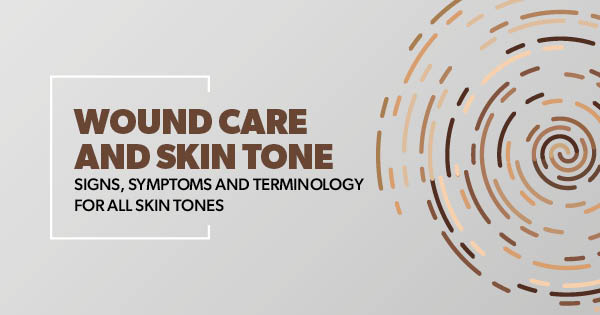ReferencesAl Shamsi H, Almutairi AG, Al Mashrafi S, Al Kalbani T (2020) Implications of Language Barriers for Healthcare: A Systematic Review. Oman Med J 35(2): e122
Battie C, Gohara M, Verschoore M, Roberts W (2013) Skin cancer in skin of color: an update on current facts, trends, and misconceptions. Journal of Drugs in Dermatology 12(2): 194-8
British Association of Dermatologists (2021) Describing erythema in skin of colour. Available at: https://www.bad.org.uk/healthcareprofessionals/inclusivity-and-representation/erythema-in-skin-of-colour (accessed 12.10.2022)
Campbell-Stephens R (2020) Global Majority: Decolonising the language and reframing the conversation about race. Available at: https://www.leedsbeckett.ac.uk/-/media/files/schools/school-of-education/final-leeds-beckett-1102-global-majority.pdf (accessed 10.10.2022)
Dhoonmoon L, Fletcher J, Atkin L (2021) Best Practice Statement. Addressing skin tone bias in wound care: assessing signs and symptoms in people with dark skin tones. Wounds UK
Everett JS, Budescu M, Sommers MS (2012) Making sense of skin color in clinical care. Clin Nurs Res 21(4): 495-516
Fletcher J, Edwards-Jones V, Fumarola S et al (2020) Best Practice Statement: Antimicrobial stewardship strategies for wound management. Wounds UK
Gulf Diabetic Foot Working Group (2017) Identification and management of infection in diabetic foot ulcers: International consensus. Wounds International
Gupta V, Sharma VK (2019) Skin typing: Fitzpatrick grading and others. Clinics in Dermatology 37: 430-6
Harkin G (2010) Management of foot burns in a patient with diabetes. Wounds UK 6(4)
Ho BK, Robinson JK (2015) Color bar tool for skin type self-identification: a cross-sectional study. J Am Acad Dermatol 73(2): 312-3
Institute of Medical Illustrators (2019) IMI National Guidelines: Wound Management Photography. Available at: https://www.imi.org.uk/wp-content/uploads/2019/04/2019_Apr_IMINatGuidelines_Wound-Management.pdf (accessed 14.10.2022)
Interagency Coordinating Group on Antimicrobial Resistance (2019) No time to wait: Securing the future from drug-resistant infections. Report to the Secretary-General of the United Nations. Interagency Coordinating Group on Antimicrobial Resistance. Available at: https://www.who.int/antimicrobialresistance/interagency-coordination-group/finalreport/en (accessed 14.10.2022)
Khunkaew S, Fernandez R, Sim J (2019) Health-Related Quality of Life and Self-Care Management Among People With Diabetic Foot Ulcers in Northern Thailand. SAGE open nursing 5: 2377960819825751
Kibadi K (2022) Time to removal of sutures from the palmar surface of the hand in dark-skinned patients: Results in a prospective cohort of 146 hands. Hand Surg Rehabil 41(1): 142-8
King’s Fund (2021) Inclusive language in health and care: why the words we use matter. Available at: https://www.kingsfund.org.uk/blog/2021/08/
inclusive-language-health-and-care (accessed 3.11.2022)
Lee AY (2021) Skin pigmentation abnormalities and their possible relationship with skin aging. Int J Mol Sci 22(7): 3727
Linos E, Keiser E, Fu T et al (2011) Hat, shade, long sleeves, or sunscreen? Rethinking US sun protection messages based on their relative effectiveness. Cancer Causes & Control 22(7): 1067-71
MacKenzie E (2000) Epidemiology of Injuries: current trends and future challenges. Epidemiol Rev 22(1): 112-8
Masub N, Khachemoune A (2022) Cosmetic skin lightening use and side effects. The Journal of Dermatological Treatment 33(3): 1287-92
Moore Z, Bell T, Carville K et al (2016) International Best Practice Statement: Optimising patient involvement in wound management Wounds International
Mukwende M (2020) Mind the Gap: A clinical handbook of signs and symptoms in black and brown skin. Wounds UK 16(3): 16
Nair HKR, Chew KY, Jun Y et al (2020) International Consensus Document: Diabetic foot ulcer care in the Asia-Pacific region. Wounds International
Oozageer Gunowa N (2022) Skin tone bias and wound care: highlighting the current evidence and addressing the gaps in knowledge of dark skin tones. Wounds UK 18(1): 22-7
Oozageer Gunowa N, Hutchinson M, Brooke J et al (2017) Pressure injuries in people with darker skin tones: A literature review. Journal of Clinical Nursing 27(17-18): 3266-75
Sandy-Hodgetts K, Ademuyiwa A, Awang P et al (2022) Incision care and dressing selection in surgical incision wounds: Findings from an international meeting of surgeons and wound care specialists from Africa. Wounds International
Toppino S, Koffi DY, Kone B et al (2022) Community-based wound management in a rural setting of Côte d’Ivoire. PLoS Neglected Tropical Diseases 16(10): e0010730
UK General Medical Council (2019) The state of medical education and practice in the UK 2019. Available at: https://www.gmc-uk.org/-/media/documents/somep-2019—full-report_pdf-81131156.pdf (accessed 13.01.2023)
Wang A, Lv G, Cheng X et al (2020) Guidelines on multidisciplinary approaches for the prevention and management of diabetic foot disease. Trauma 6: 8tkaa017
World Health Organization (2009) WHO guidelines on hand hygiene in health care. Available at: https://www.who.int/publications/i/item/9789241597906 (accessed 3.11.2022)
World Health Organization (2016) Patient engagement: Technical series on safer primary care. Available at: https://www.who.int/publications/i/item/9789241511629 (accessed 17.01.2023)
World Union of Wound Healing Societies (2020) Optimising wound care through patient engagement. Wounds International
Wounds UK (2021) Best Practice Statement: Addressing skin tone bias in wound care: assessing signs and symptoms in people with dark skin tones. Wounds UK







